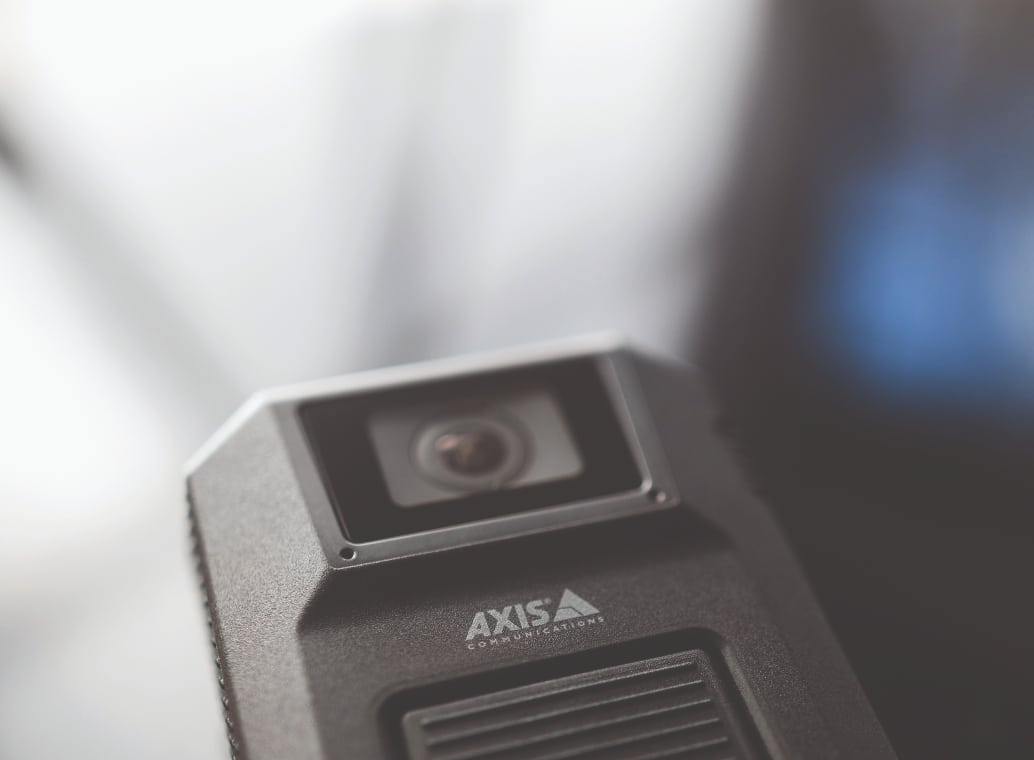
Viktor Svärm, Solutions Engineer and Ian James, UK Sales Engineering and Training Manager at Axis Communications reveal what’s new and what’s next in the company’s range of body worn cameras.
Axis Communications is no stranger to security. The Swedish manufacturer of network cameras, access control, and network audio devices for the physical security and video surveillance industries is nearly 30 years old.
Committed to enabling a smarter, safer world, Axis Communications launched its body worn camera range in 2020. Body worn solutions document events and capture valuable evidence. As a deterrent for bad behaviour, they positively influence the actions of camera wearers and the public alike.
Here, Svärm and James explain the purpose and benefits of the range and the updates that have been made to it since.

Viktor Svärm (VS): Axis body worn cameras offer a robust and lightweight security solution for law enforcement and private security teams. These cameras represent the next generation of physical security, providing flexible surveillance on the move, often in challenging situations, and meeting Axis’ usual high standards when it comes to quality, ease of use, design and usability.
VS: The use of open platforms and dedicated APIs means that integration with multiple video management systems (VMS) as well as evidence management systems (EMS) is quick and simple. Open system architecture also facilitates simple integration with a broad range of third-party systems, which promotes collaboration with Axis Communications partners to work on future enhancements to the technology or new ways in which it can be used and developed. The inclusion of a three-year warranty is a major plus point for our customers as it demonstrates our confidence in the product and gives them extra peace of mind.
Ian James (IJ): Obvious challenges related to finding the optimum combination of size, weight, the need for robustness and maximising battery life. To get all these elements right, our research and design team consulted with customers to gauge their requirements. This resulted in the development of multiple product prototypes and several early-stage pilot projects. A holistic view was taken, factoring in a range of requirements from initial video capture in the field, right through to the presentation of evidence in the courtroom, where the authenticity and integrity of the video evidence is critical.

IJ: When we launched our body worn solutions they added a new layer to our portfolio, covering the wearable market. The first-person perspective gained from a body worn camera can complement a fixed camera solution, capturing real-time evidence of a situation at the point at which it occurs. Integration with an operator’s VMS allows one system to monitor all cameras, both wearable and fixed, and enables the data from both wearable and fixed solutions to be combined, building an accurate incident report. The cameras include 64GB of storage, providing security personnel with enough capacity to capture high-definition video throughout even the most gruelling of shifts, up to 17 hours operating time.
VS: During the launch period, the solution was thoroughly trialled in a wide variety of applications within the private security space. These included use by security personnel at football stadiums and at other large events prior to the COVID-19 pandemic. The solution was also rigorously tested by law enforcement teams. Feedback was very positive, especially around key features such as battery lifetime, pre-recording buffer, recording retention and image quality. The unit itself is rugged and has been praised for its extreme durability as well as its simplistic operation, ideal for use in high-pressure scenarios where split-second decision-making is crucial.
Today and into the future, body-worn cameras have the potential for use within a wide range of industries and sectors. Examples include public transport operatives and ticket inspectors, emergency services personnel, healthcare professionals, utility workers and other areas where operatives can become targets of aggression and abuse, or where the nature of their work means that they are at risk of injury.
There are also benefits from an operational and health and safety perspective. Consider a busy construction site in which body-worn solutions can not only provide documented evidence of work being carried out, or of safety protocols being followed, but can also capture vital video of any accident or incident, particularly beneficial in areas of high risk.
IJ: Body Worn Live was a major update to our body worn technology. It has enabled us to deliver live data streaming in the form of video, audio, and metadata from Axis Communications body worn cameras. AXIS Body Worn Live supports informed decision-making by operators, enhances intelligence gathering for incident response teams (IRTs) and provides an added sense of safety for camera wearers. Some of the key benefits include 24-hour data retention, end-to-end encryption, and data gap retrieval. It also works independently of the choice of VMS and data streams can be viewed on computers or mobile devices.
IJ: Due to the amount of positive feedback we have already received, and the multiple scenarios in which the technology has been successfully put through its paces and used, there are of course plans to grow the product line. We are already on our second iteration of the body worn, the AXIS W101, which features significant improvements to ensure excellent image and audio quality and improved great battery life. We expect further updates soon.
We see the potential for the technology to be incorporated into security training programmes, and its use as a visual deterrent to help keep situations under control has already been noted.
Axis Communications provides accessory lenses to give extra options around how the cameras can be mounted according to the application.
Further modifications and refinements resulting from continued customer feedback will help to further improve this already first-class security solution.